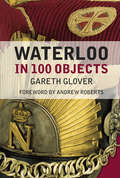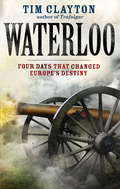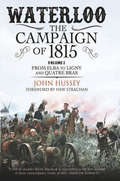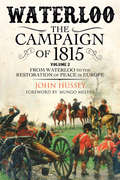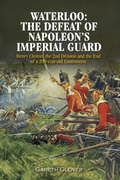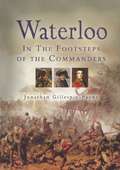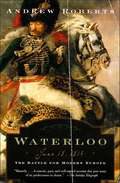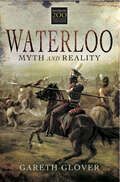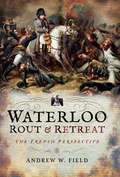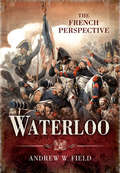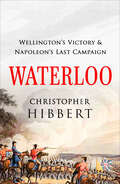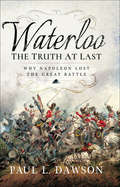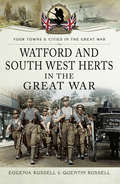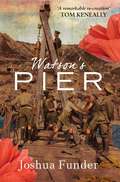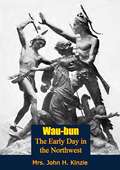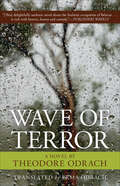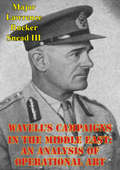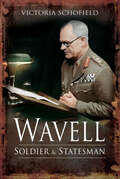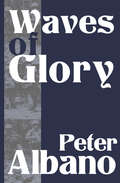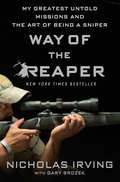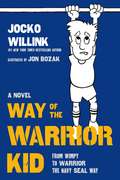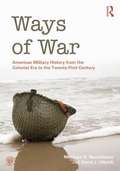- Table View
- List View
Waterloo in 100 Objects
by Gareth Glover Andrew RobertsObjects allow us to reach out and touch the past and they play a living role in history today. Through them we can come closer to the reality experienced by the soldiers who fought at Waterloo – that most iconic of all battles. Using stunning photography, rare objects from the Napoleonic era tell us their story of the battle. From the discomfort of the uniforms to the drama of the battle-drums echoing across the battlefield, by examining each object and its place in the Waterloo story, we reach a deeper understanding of what happened on the battlefield and its significance today. Gareth Glover takes us on fascinating journey through 100 objects, from the rare to the memorable, in a unique testimony to importance of the battle of Waterloo, 200 years on.
Waterloo: Four Days that Changed Europe's Destiny
by Tim Clayton'A fabulous story, superbly told' Max HastingsThe bloodbath at Waterloo ended a war that had engulfed the world for over twenty years. It also finished the career of the charismatic Napoleon Bonaparte. It ensured the final liberation of Germany and the restoration of the old European monarchies, and it represented one of very few defeats for the glorious French army, most of whose soldiers remained devoted to their Emperor until the very end. Extraordinary though it may seem much about the Battle of Waterloo has remained uncertain, with many major features of the campaign hotly debated. Most histories have depended heavily on the evidence of British officers that were gathered about twenty years after the battle. But the recent publication of an abundance of fresh first-hand accounts from soldiers of all the participating armies has illuminated important episodes and enabled radical reappraisal of the course of the campaign. What emerges is a darker, muddier story, no longer biased by notions of regimental honour, but a tapestry of irony, accident, courage, horror and human frailty.An epic page turner, rich in dramatic human detail and grounded in first-class scholarly research, Waterloo is the real inside story of the greatest land battle in British history, the defining showdown of the age of muskets, bayonets, cavalry and cannon.
Waterloo: From Elba to Ligny and Quatre Bras
by John HusseyThis, the fourth volume in Andrew Field's highly praised study of the Waterloo campaign from the French perspective, depicts in vivid detail the often neglected final phase the rout and retreat of Napoleon's army. The text is based exclusively on French eyewitness accounts which give an inside view of the immediate aftermath of the battle and carry the story through to the army's disbandment in late 1815. Many French officers and soldiers wrote more about the retreat than they did about the catastrophe of Waterloo itself. Their recollections give a fascinating insight to the psyche of the French soldier. They also provide a firsthand record of their experiences and the range of their reactions, from those who deserted the colors and made their way home, to those who continued to serve faithfully when all was lost. Napoleons own flight from Waterloo is an essential part of the narrative, but the main emphasis is on the fate of the beaten French army as it was experienced by eyewitnesses who lived through the last days of the campaign.
Waterloo: From Waterloo to the Restoration of Peace in Europe
by John HusseyWinner of the 2019 RUSI Duke of Wellington Medal for Military HistoryWinner of the 2017 Society for Army Historical Research Templer MedalShortlisted for Military History Monthly's "Book of the Year" AwardThe first of two groundbreaking volumes on the Waterloo campaign, this book is based upon a detailed analysis of sources old and new in four languages. It highlights the political stresses between the Allies, and their resolution; it studies the problems of feeding and paying for 250,000 Allied forces assembling in Belgium during the undeclared war, and how a strategy was thrashed out. It studies the neglected topic of how the slow and discordant Allies beyond the Rhine hampered the plans of Blcher and Wellington, thus allowing Napoleon to snatch the initiative from them. Napoleons operational plan is analyzed (and Soult's mistakes in executing it). Accounts from both sides help provide a vivid impression of the fighting on the first day, 15 June, and the volume ends with the joint battles of Ligny and Quatre Bras the next day.
Waterloo: Henry Clinton, the 2nd Division and the End of a 200-year Old Controversy
by Gareth Glover&“This in-depth study of the nuts and bolts of a single division is without a doubt the best book I have ever read on Waterloo.&”—The Napoleon Series Winner of the 2017 Society for Army Historical Research Templer Medal This is the most detailed account of the 2nd Division at Waterloo ever published. It is based on the papers of its commander Sir Henry Clinton, and it reveals for the first time the previously unrecognized vital role this division made in the defeat of Napoleon. Author Gareth Glover explains how the division was placed ahead of the main allied squares thus impeding the charges of the French cavalry, and how the 2nd Division supported the defense of Hougoumont, considered by the Duke of Wellington as the key to his victory on 18 June 1815. Perhaps the most significant aspect of this book is the description of the defeat of Napoleon&’s Imperial Guard. Just how the incomparable Guard was stopped and then driven from the battlefield is explained in detail. Once and for all, this 200-year controversy is finally resolved. &“Does a superb job of dissecting the controversy over whether it was Adam&’s Brigade or the Guard&’s Brigade that was instrumental in defeating the Imperial Guard.&”—The Napoleon Series
Waterloo: In The Footsteps Of The Commanders
by Jonathan Gillespie-PayneThis is an EXACT reproduction of a book published before 1923. This IS NOT an OCR'd book with strange characters, introduced typographical errors, and jumbled words. This book may have occasional imperfections such as missing or blurred pages, poor pictures, errant marks, etc. that were either part of the original artifact, or were introduced by the scanning process. We believe this work is culturally important, and despite the imperfections, have elected to bring it back into print as part of our continuing commitment to the preservation of printed works worldwide. We appreciate your understanding of the imperfections in the preservation process, and hope you enjoy this valuable book.
Waterloo: June 18, 1815—The Battle for Modern Europe (Making History)
by Andrew RobertsThe New York Times–bestselling historian’s “masterly . . . concise, pacy, and well-argued account” of Napoleon’s final defeat (The Sunday Telegraph).June 18, 1815, was one of the most momentous days in world history, marking the end of twenty-two years of French Revolutionary and Napoleonic Wars. On the bloody battlefield of Waterloo, the Emperor Napoleon and his hastily formed legions clashed with the Anglo-Allied armies led by the Duke of Wellington—the only time the two greatest military strategists of their age faced each other in combat.With precision and elegance, Andrew Roberts sets the political, strategic, and historical scene, providing a breathtaking account of each successive stage of the battle while also examining new evidence that reveals exactly how Napoleon was defeated. Waterloo is “a vivid, thoughtful, and blessedly concise account” of the battle that “marks the beginning of the modern era” (Kirkus, starred review).
Waterloo: Myth And Reality
by Gareth Glover&“A radical re-assessment . . . This is fascinating stuff . . . a most useful addition to the Waterloo—and indeed Napoleonic—bookshelf.&”—Military Modelling Magazine More has probably been written about the Waterloo campaign than almost any other in history. It was the climax of the Napoleonic Wars and forms a watershed in both European and world history. However, the lethal combination of national bias, willful distortion and simple error has unfortunately led to the constantly regurgitated traditional &“accepted&” version being significantly wrong regarding many episodes in the campaign. Oft-repeated claims have morphed into established fact, and it is high time that these are challenged and finally dismissed. Gareth Glover has spent a decade uncovering hundreds of previously unpublished eyewitness accounts of the battle and campaign, which have highlighted many of these myths and errors. In this groundbreaking history, based on extensive primary research of all the nations involved, he provides a very readable and beautifully balanced account of the entire campaign while challenging these distorted claims and myths, and he provides clear evidence to back his version of events. His thoughtful reassessment of this decisive episode in world history will be stimulating reading for those already familiar with the Napoleonic period, and it will form a fascinating introduction for readers who are discovering this extraordinary event for the first time. &“An enjoyable and informative review of the battle that shaped Europe for the next two centuries.&”—Firetrench
Waterloo: The Aftermath
by Paul O'KeeffeThe consequences of Napoleon&’s most famous defeat are explored in this &“highly readable, richly anecdotal retelling of the battle&’s devastating results&” (Kirkus). In the early morning hours of June 19, 1815, more than 50,000 men and 7,000 horses lay dead and wounded on a battlefield just south of Brussels. In the hours, days, weeks, and months that followed, news of the battle would begin to shape the consciousness of an age; the battlegrounds would be looted and cleared, its dead buried or burned, its ground and ruins overrun by tourists; the victorious British and Prussian armies would invade France and occupy Paris. And for Napoleon, there was no avenue ahead but surrender, exile and captivity. In this dramatic account of the aftermath of the Battle of Waterloo, Paul O'Keeffe employs a multiplicity of contemporary sources and viewpoints to create a reading experience that brings into focus as never before the sights, sounds, and smells of the battlefield, of conquest and defeat, of celebration and riot.
Waterloo: The French Perspective
by Andrew W. Field&“This book covers the least familiar part of the Waterloo campaign—the French retreat in the aftermath of the battle . . . a splendid study.&” —History of War This, the fourth volume in Andrew Field&’s highly praised study of the Waterloo campaign from the French perspective, depicts in vivid detail the often neglected final phase—the rout and retreat of Napoleon&’s army. The text is based exclusively on French eyewitness accounts which give an inside view of the immediate aftermath of the battle and carry the story through to the army&’s disbandment in late 1815. Many French officers and soldiers wrote more about the retreat than they did about the catastrophe of Waterloo itself. Their recollections give a fascinating insight to the psyche of the French soldier. They also provide a first-hand record of their experiences and the range of their reactions, from those who deserted the colours and made their way home, to those who continued to serve faithfully when all was lost. Napoleon&’s own flight from Waterloo is an essential part of the narrative, but the main emphasis is on the fate of the beaten French army as it was experienced by eyewitnesses who lived through the last days of the campaign. &“A fine conclusion to Andrew Field&’s series of books on the Hundred Days&’ Campaign that offers a rather different perspective on the subject and is a book all serious Napoleonic wargamers will surely wish to add to their libraries.&” —Miniature Wargames
Waterloo: The French Perspective
by Andrew W. FieldFrom the author of Talavera, an extensive history of the Battle of Waterloo from the losing side&’s point of view. The story of the Battle of Waterloo—of the ultimate defeat of Napoleon and the French, the triumph of Wellington, Blücher, and their allied armies—is most often told from the viewpoint of the victors, not the vanquished. Even after 200 years of intensive research and the publication of hundreds of books and articles on the battle, the French perspective and many of the primary French sources are under-represented in the written record. So, it is high time this weakness in the literature—and in our understanding of the battle—was addressed, and that is the purpose of Andrew Field&’s thought-provoking new study. He has tracked down over ninety first-hand French accounts, many of which have never been previously published in English, and he has combined them with accounts from the other participants in order to create a graphic new narrative of one of the world&’s decisive battles. Virtually all of the hitherto unpublished testimony provides fascinating new detail on the battle and many of the accounts are vivid, revealing, and exciting.
Waterloo: Wellington's Victory & Napoleon's Last Campaign
by Christopher HibbertA portrait of Napoleon Bonaparte, the Duke of Wellington, and the fateful clash of their armies in 1815 from &“a remarkably good writer&” (The New York Times). It was the greatest of battles—the defining military engagement of the nineteenth century that forever ended one man&’s dreams of a European empire unified under his rule. This epoch-defining conflict would ultimately be remembered for the showdown between two of history&’s most legendary commanders: the Duke of Wellington, and Napoleon Bonaparte. In this definitive account divided into three parts, Christopher Hibbert masterfully depicts first Napoleon and his rise to power, then Wellington and the allied armies, and lastly the steps leading up to the battle and the battle itself, the final clash on the fields of Waterloo. It is a gripping, succinct and panoramic survey of this legendary event, the history surrounding it, and the personalities that defined it. Praise for the work of Christopher Hibbert &“Well-written, lucid, and vivid.&” —The Washington Post &“Interesting detail.&” —Booklist &“A skillful storyteller and historian.&” —Publishers Weekly
Waterloo: Why Napoleon Lost the Great Battle
by Paul L. DawsonDuring October 2016 Paul Dawson visited French archives in Paris to continue his research surrounding the events of the Napoleonic Wars. Some of the material he examined had never been accessed by researchers or historians before, the files involved having been sealed in 1816. These seals remained unbroken until Paul was given permission to break them to read the contents.Forget what you have read about the battle on the Mont St Jean on 18 June 1815; it did not happen that way. The start of the battle was delayed because of the state of the ground not so. Marshal Ney destroyed the French cavalry in his reckless charges against the Allied infantry squares wrong. The stubborn defense of Hougoumont, the key to Wellingtons victory, where a plucky little garrison of British Guards held the farmhouse against the overwhelming force of Jerome Bonapartes division and the rest of II Corps not true. Did the Union Brigade really destroy dErlons Corps, did the Scots Greys actually attack a massed French battery, did La Haie Sainte hold out until late in the afternoon?All these and many more of the accepted stories concerning the battle are analysed through accounts (some 200 in all) previously unpublished, mainly derived through French sources, with startling conclusions. Most significantly of all is the revelation of exactly how, and why, Napoleon was defeated.Waterloo, The Truth at Last demonstrates, through details never made available to the general public before, how so much of what we think we know about the battle simply did not occur in the manner or to the degree previously believed. This book has been described as a game changer, and is certain to generate enormous interest, and will alter our previously-held perceptions forever.
Watford and South West Herts in the Great War (Your Towns & Cities in the Great War)
by Eugenia Russell Quentin RussellThis book highlights the importance of Watford as a regional centre within South West Herts during the years of the Great War as well as the cohesion of the local area and the impact events and initiatives had on the entire region. The organization and presence of the Army are discussed before focusing on different aspects of civilian life such as the contribution of civilians to the war effort, the Police and Fire Service, the role of Churches, Schools and the Press and changes in employment and local businesses. As the War wore on and the magnitude of the sacrifice sunk in, hospitals and charities became more prominent. The latter part of the book presents these as well as the many public and private ways of commemorating the War Dead in the aftermath of the conflict. The distinctiveness of such Memorials reflects the legacy of the Arts and Crafts Movement and the artistic communities resident in Bushey and Watford.
Watson's Pier
by Joshua FunderOn 20 December 1977, as Stanley Watson takes the slow train journey to family Christmas, memories from over 60 years ago play in his mind. He had been and still was a man of his time, as as steady, simple and direct as the railway lines he built. As an engineer in the 28th Signalling Company, recently wed and with a young child, he knew it to be his duty to enlist as soon as war broke out in 1914. He left for Egypt in October and he knows his wife is pregnant as he reaches Gallipoli on 25 April 1915, a participant in that fateful landing that is writ large in Australian history. He survived that landing to construct the first pier at Anzac Cove, from which the Anzacs withdrew on the nights of 18 and 19 December. For a long time, he was known as the last man to leave Gallipoli. Watson's Pier is a beautifully told story as seen through the eyes of Stanley Watson, one of the leaders of the escape from Gallipoli. It draws on Watson's story, his writing, oral history and the official war records. While telling one man's remarkable experience of war for the first time, Watson's Pier challenges history on the final moments at ANZAC Cove and offers a new perspective on the meaning of Gallipoli.
Wau-bun, The Early Day in the Northwest: The Early Day In The Northwest
by Mrs John H. Kinzie Dr Louise Phelps KelloggOriginally published in 1856, and then edited (with notes and introduction) by Louise Phelps Kellogg and republished in 1930, there is no better description of early Chicago and the famous Fort Dearborn Massacre to be found anywhere than that contained in Wau-bun, The Early Day in the Northwest.Among the familiar characters who come into the story are Governor James D. Doty, Jefferson Davis, John Lowe, Col. Wm. S. Hamilton, son of Alexander Hamilton, Eleazar Williams, Augustin Grignon, Jacques Porlier, Chief Four Legs, and many others.The garrison life at Forts Howard and Winnebago, the dangerous passage of the rapids of the Fox River in the Mackinac boats, and the customs of the Wisconsin Indians of the period are all vividly told in this classic.Unmissable American historical literature.“Mrs. Kinzie’s account of the early day in Wisconsin is delightful; it sparkles with humor and with the pleasure of youth in new and strange adventures. The spirit of happiness pervades it and the author’s affectionate sympathy for her husband’s Indian ‘children’ shines on every page. Her description of travel and its vicissitudes in Wisconsin of the early day is full of fun and jollity. She was what we would call today a ‘good sport,’ taking everything with philosophy and good will. The feast of good things is spread for the reader; all that remains is enjoyment of the narration.”—Louise Phelps Kellogg, Introduction
Wave of Terror: A Novel
by Theodore OdrachThis novel is a major literary discovery, and Odrach is drawing favorable comparisons with such eminent writers as Chekhov and Solzhenitsyn. Odrach wrote in Ukrainian, while living an exile's life in Toronto. This remarkable book is a microcosm of Soviet history, and Odrach provides a first-hand account of events during the Stalinist era that newsreels never covered. It has special value as a sensitive and realistic portrait of the times, while capturing the internal drama of the characters with psychological concision. Odrach creates a powerful and moving picture, and manages to show what life was really like under the brutal dictatorship of Stalin, and brings cataclysmic events of history to a human scale.
Wavell's Campaigns In The Middle East: An Analysis Of Operational Art
by Major Lawrence Rucker Snead IIIToday the United States confronts an uncertain world. The strategic environment has changed. It no longer has one main enemy and a military force to confront that foe. Instead, the United States must be prepared to deal with a multiple of possible threats as its military continues to downsize. This new regional orientation and world situation requires that the US Military be ready to fight simultaneous major regional contingencies to achieve the victories that the American people expect.Therefore, this study examines Field Marshall Wavell's campaigns in the Middle East in WWII to provide a historical case study of a similar situation. There he had to simultaneously conduct a large number of campaigns and operations over four theaters of operations against different enemies under difficult conditions to achieve strategic objectives. It compares this case study with the current strategic military requirements facing the US and current US Military doctrine to determine if the US is prepared to deal with multiple simultaneous regional contingencies.Finally, this monograph indicates that the US Military needs to update both its National Military Strategy and it's doctrine in order to be prepared to fight and win multiple simultaneous major regional contingencies in the future. In addition, this study has indicated a number of implications for the conduct of operational art by the US Military.
Wavell: Soldier and Statesman
by Victoria SchofieldArchibald Wavells life and career makes a marvelous subject. Not only did he reach the highest rank (Field Marshal) and become an Earl and Viceroy of India but his character was complex. He joined the Black Watch in 1901. He stood out during the Great War, quickly earning the Military Cross but losing an eye. He was at Versailles in 1918 but between the Wars his career advanced with Brigade and General commands notably in Palestine where he spotted Orde Wingate. By the outbreak of war he was GOC-in-C Middle East. Early successes against the Italians turned into costly failures in Greece and Crete and Wavell lost the confidence of Churchill; their temperaments differed completely. Wavell was sent to India as C-in-C. After Pearl Harbor Wavell was made Supreme Allied Commander for the SW Pacific and bore responsibility for the humiliating loss of Singapore (he quickly recognized that it could not be held). Problems in Burma tested Churchills patience and he was removed from command to be Viceroy and Governor General of India. As civil unrest and demands for independence grew, in 1947 Prime Minister Attlee replaced Wavell with Mountbatten who oversaw Partition. Wavell died in 1950, after a life of huge achievement tempered with many reverses, most of which were not of his making.
Waves of Glory
by Peter AlbanoWaves of Glory follows four British men of privilege watching the decimation of their generation in the trenches of the World War I battlefields. As the soldiers try to cope with the blood, violence, and death all around them, their world falls apart and nothing seems real except the overwhelming urgency of survival. The home front is no less compelling, as Albano illustrates the pain and uncertainty of waiting for the daily casualty lists that might include a brother, father, lover, or husband. The emotional energy of the men, the women they love, and their comrades in arms brings home the lessons that were arduously learned yet quickly forgotten in the &“war to end all wars.&”
Waves of Hate: Naval Atrocities of the Second World War
by Tony BridglandWhilst researching his earlier book Sea Killers in Disguise, the author unearthed a rich stem of incidents at sea which happened during the two World Wars that shocked and surprised him. This book is the result of further in-depth study covering the Second World War. It reveals a long catalogue of atrocities perpetrated not just by Germany and Japan but, sensationally, by the British and her Allies.Thanks to Tony Bridgland's meticulous research, into a wide variety of incidents at sea, makes for vivid and compelling, if uneasy, reading
Waves of War: Nationalism, State Formation, and Ethnic Exclusion in the Modern World
by Andreas WimmerWhy did the nation-state emerge and proliferate across the globe? How is this process related to the wars fought in the modern era? Analyzing datasets that cover the entire world over long stretches of time, Andreas Wimmer focuses on changing configurations of power and legitimacy to answer these questions. The nationalist ideal of self-rule gradually diffused over the world and delegitimized empire after empire. Nationalists created nation-states wherever the power configuration favored them, often at the end of prolonged wars of secession. The elites of many of these new states were institutionally too weak for nation-building and favored their own ethnic communities. Ethnic rebels challenged such exclusionary power structures that violated the principle of self-rule, and neighboring governments sometimes intervened into these struggles over the state. Waves of War demonstrates why nation-state formation and ethnic politics are crucial to understand the civil and international wars of the past 200 years.
Way of the Reaper: My Greatest Untold Missions and the Art of Being a Sniper
by Gary Brozek Nicholas IrvingFrom the New York Times Bestselling Author and Co-Star of Fox's American Grit comes a rare and powerful book on the art of being a sniper. Way of the Reaper is a step-by-step accounting of how a sniper works, through the lens of Irving's most significant kills - none of which have been told before. Each mission is an in-depth look at a new element of eliminating the enemy, from intel to luck, recon to weaponry. Told in a thrilling narrative, this is also a heart-pounding true story of some of The Reaper's boldest missions including the longest shot of his military career on a human target of over half a mile.In Iraq and Afghanistan, Nick Irving earned his nickname in blood, destroying the enemy with his sniper rifle and in deadly firefights behind a .50 caliber machine gun. He engaged a Taliban suicide bomber during a vicious firefight, used nearly silent sub-sonic ammo, and was the target of snipers himself. Way of the Reaper attempts to place the reader in the heat of battle, experiencing the same dangers, horrors and acts of courage Irving faced as an elite member of the 3rd Ranger Battalion, 75th Ranger Regiment, while also examining the personal ramifications of taking another life.Readers will experience the rush of the hunt and the dangers that all snipers must face, while learning what it takes to become an elite manhunter. Like the Reaper himself, this explosive book blazes new territory and takes no prisoners.
Way of the Warrior Kid: From Wimpy to Warrior the Navy Seal Way
by Jocko WillinkFifth grade was the worst year of Marc's life. He stunk at gym class, math was too hard for him, the school lunch was horrible, and his class field trip was ruined because he couldn't swim. But what was the most awful thing about fifth grade? Kenny Williamson, the class bully, who calls himself the "King of the Jungle. " When Marc's mother tells him that his Uncle Jake is coming to stay for the whole summer, Marc can't wait. Uncle Jake is a for real, super-cool Navy SEAL. And Uncle Jake has a plan. He's going to turn Marc into a warrior. Becoming a warrior isn't easy. It means a lot of pull ups, sit ups, pushups, squats, swimming, eating right, and studying harder than ever before! Can Marc transform himself into a warrior before school starts in the fall - and finally stand up to the King of the Jungle himself? The Way of the Warrior Kid is a new illustrated chapter book by #1New York Times-bestselling author and retired Navy SEAL Jocko Willink.
Ways of War: American Military History from the Colonial Era to the Twenty-First Century
by Matthew S. Muehlbauer David J. UlbrichFrom the first interactions between European and native peoples, to the recent peace-keeping efforts in Afghanistan and Iraq, military issues have always played an important role in American history. Ways of War comprehensively explains the place of the military within the wider context of the history of the United States, showing its centrality to American culture and politics. The chapters provide a complete survey of the American military's growth and development while answering such questions as: How did the American military structure develop? How does it operate? And how have historical military events helped the country to grow and develop?<P><P> Features Include:<P> * Chronological and comprehensive coverage of North American conflicts since the seventeenth century and international wars undertaken by the United States since 1783<P> * Over 100 maps and images, chapter timelines identifying key dates and events, and text boxes throughout providing biographical information and first person accounts<P> * A companion website featuring an extensive testbank of discussion, essay and multiple choice questions for instructors as well as student study resources including an interactive timeline, chapter summaries, annotated further reading, annotated weblinks, additional book content, flashcards and an extensive glossary of key terms.<P> Extensively illustrated and written by experienced instructors, Ways of War is essential reading for all students of American Military History.
